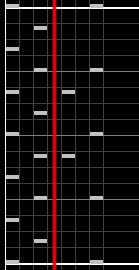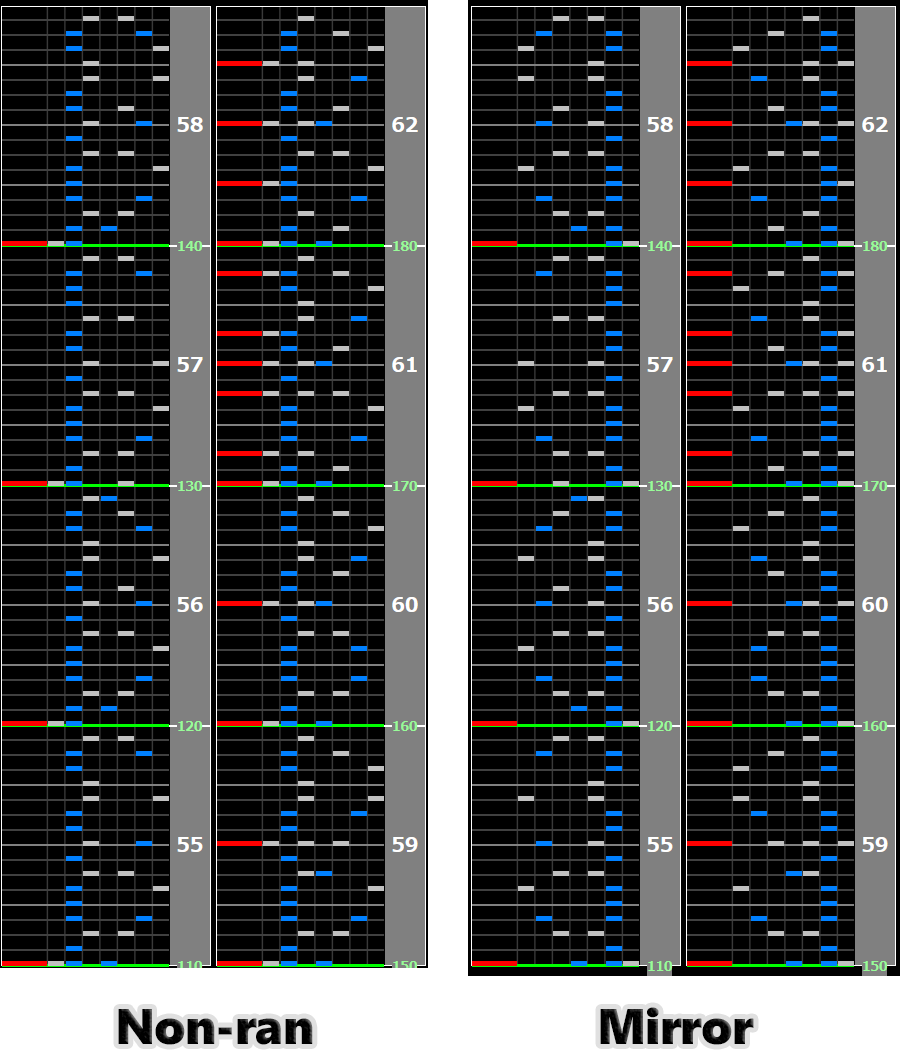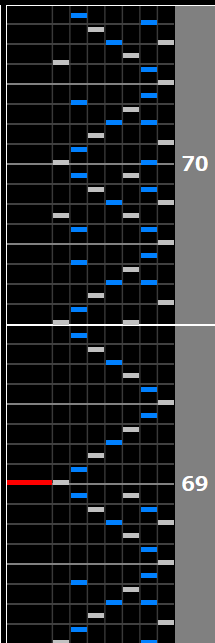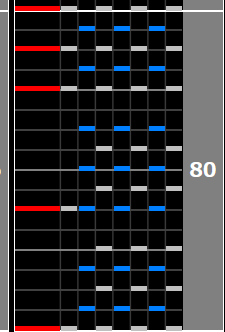Tips to reach SP Kaiden
Table of contents
- Introduction
- Tips
- FAQ
Introduction
This page a collection of various tips and suggestions for chuuden (中伝) players aiming for kaiden (皆伝).
Consider this an opinion piece; suggestions here may or may not be useful to you. Everyone is different. Players come from various gaming backgrounds; some play many other rhythm games, some only play IIDX; physical abilities greatly differ from person to person; some people have more free time, some people can’t afford to play at home.
But these are common suggestions given to players aiming for kaiden.
If you are not at this level yet, or if you need a review, Tips for Intermediate Level Players would also be a good read. There will be a little bit of overlap between the two, if they are really that important.
Tips
Try Insane BMS
Playing insane BMS is the most efficient way to reach kaiden. Many players over time have proven this point over and over, and it’s not up for a debate. Some people enjoy playing insane BMS, while others may see it as a necessary evil.
See this page for details on Insane BMS.
What charts should I be playing?
Play charts in Insane1 and Satellite tables, focusing on charts around your level.
If you want to turn off your brain and play the same charts over and over with RANDOM, these are often recommended (all from Insane1):
- ★5 Angelic layer ~Reincarnation~ (146 bpm, for warm up)
- ★6 Daydreamer [SABOTHER] (177 bpm)
- ★10 水晶世界 ~Fracture~ [Insane] (180 bpm)
Leave RANDOM enabled
Ideally you’re already doing this ever since you started playing 11s, but it’s not too late. When practicing, you should almost always leave random enabled, except in extremely rare cases where the chart calls for it (e.g., Diavolo, scratch songs), or when R-RAN is more ideal (e.g., Colorful Cookie, Bitter Chocolate Striker).
https://the-japari.tumblr.com/post/167002150470/why-you-should-use-random
https://djrea.blogspot.com/2012/10/technique.html
… but don’t restart songs until you get a good random. Try to play songs to completion even if you get a bad random, if the goal is to practice.
Focus on reducing BP, go for hard clears
When playing charts that you previously played, your main focus should be on reducing the BP (bad + poor) count.
If you are a type of player to only plays on easy gauge or normal gauge, make sure you play with hard gauge as well. You can use hard gauge tier lists and start filling out lamps from the bottom.
Playing on hard gauge makes you learn how to correctly hit all notes in a song, which is a fundamental skill. If you exclusively play on easy or normal gauge, you may be (consciously or unconsciously) ignoring patterns you are not good at, such as denims, fast stairs, sof-lan, and so on.
Don’t waste too much time trying to get ex-hard lamps.
Have a proper warm-up routine
Make sure you have a proper warm-up routine when you start your session. Try not to jump straight into high 11s and 12s, but instead have a list of easier charts to warm up. This isn’t just about warming up your hand muscles; it’s about getting into the mindset, letting your eyes adjust, fine-tuning your timing, and so on.
It’s up to you what the warm-up session looks like, and how long it is.
Learn from watching others
Occasionally, you might want to check out how high-level players play the game.
- Watch videos that have hand cams, of course.
- Try to watch players that have a similar play style as you.
- Watch them play IIDX and not BMS, since the timing window differences call for slightly different methods of play.
- You don’t need to emulate everything they do, but do try to evaluate the differences.
Learn from watching yourself play
Record your gameplay (with a hand cam) and review it. This is especially helpful when you are mind blocked on certain parts of a song.
Perhaps you notice that you’re scratching at 16ths, when you really should be scratching 24ths. Maybe you notice yourself hitting the notes too fast or too slow in certain parts of a song.
Re-evaluate your green number and white number
At this level, a typical green number is between 260 to 300. If your green number deviates greatly from this, you might want to consider going back to more conventional setting and making small adjustments.
Your white number should also be not too high; see this section from Intermediate chapter.
It’s not stamina, it’s your reading ability
People often complain about lacking “stamina” when playing high level 12s or trying Kaiden. This is a bit misguided.
It’s really about your ability to read. Your eyes and your brain are much faster at processing things than your physical ability to hit patterns with your hands. When you lack the skills to read the given chart, you will unconsciously put more strain on your hand and fingers. As a result, you end up running out of “stamina” while playing a song.
Further reading: https://the-japari.tumblr.com/post/167003035375/is-finger-training-necessary
Source: https://the-safari.com/2535
Pattern recognition
This is vertical reading, where you imagine a split between left and right side. You should avoid it -

Instead, you should be using horizontal reading where you read them as a series of notes and chords:

This is one of the most important topics; others have done a better job at an explanation. Continue reading here: https://the-japari.tumblr.com/post/166760567060/horizontal-and-vertical-reading
Source: https://the-safari.com/2539
Stay motivated
This is perhaps the most important point.
Motivation keeps you going.
Use an app or a website that keeps track of your clear lamps. Celebrate small victories and milestones.
Don’t burn out by attempting kaiden over and over. Don’t try it more than once or twice a day.
Don’t compare yourself to others. This is a single player game.
Make practice a habit, but don’t turn it into a chore.
If you’re no longer having fun, take a break.
Try playing other rhythm games. Pop’n Music is very accessible and may help with horizontal reading. Try playing DP once in a while. Train your sense of rhythm with DDR. Almost all top rankers play more than one rhythm game.
FAQ
When do I try kaiden?
The general recommendation is that when you can hard clear three or four these, you are ready to try kaiden.
- Bad Maniacs
- MENDES
- quell~the seventh slave~
- HAERETICUS
- Tenkuu no Yoake (天空の夜明け)
All of these songs 地力A on the hard gauge tier list. You should be able to clear about half of all 地力A tier.
In terms of Insane BMS, it’s typical for players to have Insane 4th or 5th dan, but rarely 6th.
Non-ran or Mirror?
You might have heard from others that 1P players should try kaiden on mirror to make it easier. The main reason is that on non-ran 1P, the jacks in Mei’s speed up will be on button 2, but when mirrored, it’s on button 6.
This is NOT universally true to everyone! Keep that in mind. Mirrored kaiden can make other songs harder (namely Himiko and potentially Beach Side Bunny).

I keep failing at the end of Nageki no Ki (嘆きの樹)
If you are losing too much life around this section:

…try not to see it as staircase pattern with some crap added in. Instead, work on your horizontal reading.
If you are failing in the last denim:

take your time to practice it offline. How you hit these really depend on your play style. If you have trouble, try putting your fingers on all the keys in the “home” position of your play style, and rocking your hand forward (black keys) and then backwards (white keys).
I keep failing 灼熱Beach Side Bunny
Passing BSB is like learning to ride a bicycle. It may take a while to get there, but once you do it once, you can do it again and again without fail.
Of course, the hard part is actually getting there. Try:
- Watch hand clap videos. This is the most helpful.
- Playing it over and over again. Recommend that you play on both non-ran and mirror.
- Record you playing it with a hand cam and review it, paying attention to how fast you are scratching.
I keep failing Himiko (卑弥呼)
If you are failing in the fist half with the slowdowns, it’s a matter of getting used to the chart and its slowdowns. It’s a very unique chart, so don’t feel too bad about not being good at it immediately.
If you are failing in the chord stream section near the end (before the slowdown) - this is a matter of your skill level and horizontal reading. It is recommended that you increase your “earth power” and come back to it; insane BMS is a great way.
If you are failing while trying to “float” the end part…
- Almost always, it’s because the player floated too early. See if you can nail down the timing.
- You don’t have to float it, it is possible to just read slow. The point of floating the end of Himiko is to have more life going into Mei. If you don’t float, you’ll have less life, but you can gain it back in the beginning of Mei.
I keep failing Mei (冥)
It’s not a huge deal if you start this song with 20-30% life; but you should really aim to have a lot of life going into the slowdown, preferably 80%+. If you have trouble keeping up the gauge in the beginning of the song, perhaps you should work on your earth power and come back later. Again, practice your horizontal reading; at some point the beginning of Mei will click.
That being said, don’t give up just because you are entering the slow down with 20%. You never know if you can get through it this one time.
In the slow part of the speed-up, put all your focus on horizontal reading and hit them as chords. It’s easy to hit them too quickly; listen to the music, it’s much slower than you think for many measures.
For the speed up part, if you are playing non-ran on 1p (or mirror on 2p), consider temporarily switching to 2:5 formation, even if you don’t use that play style very often.
Here is a video of the speed up in constant scroll speed.
Here is a short BMS chart that imitates the speed up part
Here is a video with ‘clap’ sounds of the speed up
This video might also help; a bit outdated, but it explains how certain sections can be simplified or done with anmitsu.
- http://www.nicovideo.jp/watch/sm7079375 (original video in Japanese)
- https://www.youtube.com/watch?v=yGhhqPJiJcM (Korean subtitled)
Unfortunately, there is no English subtitle just yet.
Usually, people passing Kaiden for the first time get about 130 to 150 bad+poors.
